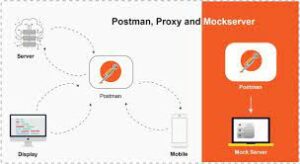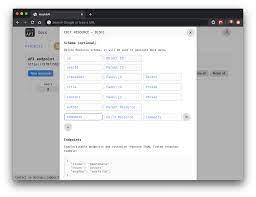A mock API, often known as a fake API, is when you create an API that returns the desired data. Still, this isn’t your real API, and some use cases have been simulated.
The Mock API can assist you in your development process and help your team develop faster.
The info in your request (necessary headers, required body, or query params) & information you will receive in the response will have the same schema as the actual API (it will provide you with the identical data structure you may have in your entire API for the response of your request).
You have the option of running your mock server on your local system or on a server. You also have the prospect of publishing them on the Internet or within the firm where you work.
Top 7 Best Free & Paid mock API tools in 2022
Top 7 Best Free & Paid mock API tools are explained here.
Mock APIs’ Advantages
To begin the integration, front-end and mobile developers often require a working API. While the back-end developers are busy creating and developing an API, the team leader would presumably prefer that the front-end or mobile developers work simultaneously.
What if the back-end devs aren’t ahead of the rest of the team? Front-end and mobile developers would be prevented from working on the project, which would cause it to slow down. So here’s the first, and most likely best, advantage of mock APIs:
Mock APIs allow front-end and mobile developers to work on their projects while back-end developers work on the real API.
Front-end and mobile developers can continue working without fear because a fake API will supply data that is identical to that of the real API. The back-end developer, on the other hand, creates the API. The front-end and mobile developers can move from Mock API to the actual API once the API is ready.
Another advantage of adopting a Mock API is that it will be tested for its accurate data schema because both front-end and back-end developers will be working on it at the same time. If the API does not deliver the desired data format while being developed, the front-end developers can warn the back-end developers, saving a lot of time.
Mock APIs make it easier to validate data schema. Back-end developers can benefit from early feedback from front-end and mobile developers.
Informing the back-end developers about potential issues while they are still working on it and focused on the problem would lessen the team’s distraction costs. Furthermore, they are focused on the existing API, are completely aware of its structure, and can change it if necessary in a fraction of the time it takes to update it after it has been developed.
Early input allows back-end engineers to make changes more quickly.
Mock APIs are widely used and popular since they save time and energy.
The following are some of the advantages of using a mock API:
- Frontend mobile and backend developers can collaborate at the same time.
- Rapid feedback loop • Early and rapid detection of bugs • Development of tests and APIs at the same time
Let’s have a look at the best 7 Mock APIs available now that we’ve learned about Mock API and its features.
1.Beeceptor
Provides both free and premium plans.
Beeceptor is a robust API mocking tool.
Beeceptor is one of the most user-friendly tools for creating phoney APIs on the market. The free version of Beeceptor has a daily request restriction, however the subscription plans let you to submit more requests per day and include additional features such as a private dashboard.
Beeceptor is referred to as an easy-to-use tool because it does not involve the usage of code. You can examine HTTP traffic and examine the payload and headers of requests. If your API server is down, you can use a Mock API to specify your desired response. Beeceptor supports CORS by default and accepts any origins, which can be useful.
Beeceptor has a Proxy mode that you can use to bypass all of your APIs, inspect their traffic, mock a few requests, and then transmit the rest to the original API.
Higher latencies can be specified in Beeceptor to imitate users with slower internet connections. Beeceptor allows A/B testing without the requirement for redeploying your application or extensive settings, which is one of the key dissimilarities between it and other mock API solutions.
2.Postman Mock Server
Provides both free and premium plans.
Mock servers are one of Postman’s many functionalities, allowing users to create false APIs.
Postman is an API Client programme with a variety of functions, including API testing, which we explored in our post about Postman API testing. The mock server is one of them. To use Postman Mock Servers, you’ll need a Postman account. Also check Church management software
One of the most appealing aspects of Postman is that its mock servers are housed on Postman Cloud, making it available from anywhere. You may also simulate network latencies, just like Beeceptor. Unfortunately, there is a request restriction in the free edition of Postman’s mock server.
3.Stoplight
Provides both free and premium plans.
Stoplight makes it simple to create phoney Restful APIs.
Stoplight allows you to run your mock APIs faster than ever before. You can even create your own own JSON schema for answers.
Prism, a popular open-source tool, is used to create the Stoplight. As a result, you can use mocking, transformations, and validations to easily turn any Open API 2, Open API 3, or Postman Collection file into an API server. Stoplight allows you to create fake Rest API endpoints using various http methods, as shown in the screenshot above.
Stoplight’s free edition allows you to create mock APIs and generate documentation for them. You can use the enterprise edition’s version control system, Collaborative API Design, and construct mock APIs for various projects without any restrictions.
Stoplight has a user-friendly interface, thus we’re talking about a high-quality UI/UX design here.
Finally, good integration with most version control systems, such as GitHub, GitLab, and Azure DevOps, makes it even more convenient and enjoyable to use.
4.Mocky
Provides both free and premium plans.
Mocky is a mock server creation tool.
Mocky is described as follows on their official website:
Mock your APIs using the world’s simplest and quickest toolkits.
Mocky is a web application, which makes it smaller, cleaner, and more user-friendly. Mocky is also fully free to use, with no advertisements, restrictions, or other restrictions. Its GitHub repository may be found here. Also check endpoint protection software
Mocky is also fully interoperable with Javascript, mobile, and server apps, with responses including CORS, JSONP, and GZIP. As a result, you may get started mocking APIs right away without having to create an account.
Mocky is a good solution if you need a quick way to develop Mock APIs, and it may even be used for educational purposes. However, it may not be a good fit for enterprise applications with a large number of APIs and collections.
5.Mockoon
Free and open-source software
Mockoon is a mock API generator that is available for free.
Mockoon is another choice if you want to work with free and open-source software. Mockoon can assist you with the implementation of your REST API mock APIs.
Unlike the remnant of this article’s list, Mockoon is a downloadable tool that allows you to mock an unlimited number of routes and environments.
You may rely on Mockoon for enterprise and large-scale projects because it provides a great collection of tools for arranging your projects into distinct contexts. Mockoon has a substantial edge over the other alternatives in this regard.
Mockoon has a user-friendly GUI, but it also features a command-line interface (CLI) for developers who don’t want to leave their keyboard! The CLI will undoubtedly save you a significant amount of time.
6.Mocki
Only premium plans have this feature.
Mocki is a premium API spoofing tool.
When you sign up with Mocki, you get a seven-day free trial. Premium features such as GitHub integration, unlimited requests, improved support, and a monitoring dashboard for your APIs are available for $10 per month.
Install the NPM package and create a setup file for your project to get started with Mocki. Mocki’s website also contains user-friendly and comprehensive documentation from which you may get started.
Mocki has functionality such as setting network latency, simulating response content, sending conditional responses, and even delivering arbitrary data as a response.
Mocki allows you to eliminate reliance on external services by handling all of the work; developing APIs, simulating error scenarios, and serving static replies are all tasks that Mocki can handle.
7.MockAPI
Provides both free and premium plans.
MockAPI is a tool that allows you to make mock APIs and servers.
MockAPI is perhaps the most basic solution you’ll come across. It’s a tool that allows you to quickly mock up APIs, produce custom data, and run actions over a RESTful interface.
MockAPI is designed to be used for prototyping, testing, and learning.
It comes with both a free and a premium plan (for which you can pay $5 per month or $35 per year). Only one project & four fake REST API endpoints are available in the free edition. The commercial version, on the other hand, comes with 20 separate projects, each with up to 50 fake REST API endpoints. Also check supply chain management
MockAPI can assist you in swiftly creating and editing resources and their relationships. MockAPI also allows you to use faker.js to generate fake data. Finally, you can collaborate with your team members by adding them.
FAQ
What is the most common scenario in which mock APIs are used?
Mock APIs are in handy when you need a simulated version of your genuine APIs to help your team develop your project faster and more efficiently.
Are there any open-source or free mock API solutions?
Yes, you can use Mocky and Mockoon in your project because they are both entirely free and open-source.
Can we use mock API tools to simulate a slow internet connection?
Yes, many of the available tools have a feature that allows you to deliberately slow down your internet connection.













